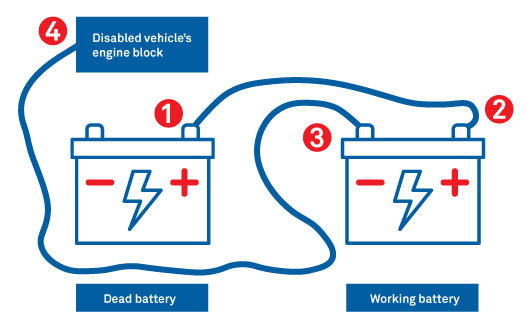Boosting a car battery: follow the guide!

Boosting a car battery may seem simple, but you have to follow the steps carefully. Your vehicle battery’s dead? Here are the options available to you as well as some practical tips for doing things safely.
Chronology of steps to follow

1) Connect a red jumper cable clamp to the positive (+) terminal of the dead battery.
2) Connect the other red cable clamp to the positive (+) terminal of the working battery.
3) Connect a black cable clamp to the negative (-) terminal of the working battery.
4) Connect the other black cable clamp to the disabled vehicle’s engine block or one of the major engine-connected metal components, such as the alternator bracket. This connection must be at least 30 cm away from the battery to prevent a spark from causing an explosion. Don’t attach the jumper cable to the ground terminal of the dead battery or to a body panel.
5) Start the engine of the car that’s providing the boost.
6) Try starting the disabled vehicle by following the cold-weather start recommendations found in the owner’s manual. Don’t engage the starter for more than 15 seconds, or you may damage it.
7) To remove the cables, follow the connection sequence in reverse order.
Caution: Failure to follow instructions when starting your car with an auxiliary battery can result in serious injury. CAA-Quebec cannot be held responsible for any personal injury or material damage resulting from the application of the method presented.
Our advice before starting the boost
- Make sure both vehicles are not in contact with each other.
- Examine the dead battery, making sure it’s not frozen. If its walls are rippled or bubbled, don’t perform the boost. Not only may a frozen battery explode, but since it’s no longer able to hold a charge, the alternator will have to work harder to power the electrical system, which may cause premature wear of this very expensive part.
- Remember that a battery releases an explosive gas called hydrogen. Watch out for sparks or any open flame. Refrain from smoking.
- It’s very uncommon for batteries to leak, but if this happens, avoid contact between the battery electrolyte and the eyes, skin and clothing of those present. Electrolyte is a corrosive solution that can cause severe burns. In the event of contact with the electrolyte, wash the affected area immediately with large quantities of water and see a doctor as soon as possible.
- Wear work gloves and remove rings and bracelets. Wearing safety goggles is strongly recommended.
- Turn off all electrical accessories (heating, lighting, air conditioning, etc.) and engage the parking brake. If your car has a manual transmission, place it in neutral; if the transmission is automatic, place it in park.
If you have any doubts, call in a professional assistance team to complete the operation safely.
Boosting a battery: follow all the instructions
You might think boosting is as simple as connecting the battery of a disabled car to that of another vehicle, but it’s not always that easy. For example, most recent-model cars have a fuse installed on the battery’s positive terminal connector to protect the electrical system from power surges. Connecting a jumper cable to the wrong side of the fuse can cause it to blow, possibly damaging one of the many electronic devices found in modern cars. You probably don’t want to pay over $1,000 to replace the on-board computer that controls all the vehicle’s critical functions, or find that the central touchscreen is no longer responsive to touch. By following our advice and performing all the steps correctly, your boost will be done safely!
Taking care of your car battery after boosting
A battery is completely dead when the engine doesn’t make a sound when you attempt to start it. Contrary to popular belief, it’s important to leave the cables connected to both running vehicles at least five minutes after the boost in order to charge the dead battery. This precaution reduces the risk of a power surge, which can occur momentarily when the jumper cables are disconnected. Once the disabled car has started, it’s best to run its heating and defrosting systems on high for a few minutes to counter the effects of a possible surge.
Dead battery? Think Roadside Assistance
Given that damage caused by a surge is not covered by any warranty, taking a chance could be very costly. If your car battery is dead, the best thing to do is call a roadside assistance service, whose experts can advise you on the procedure to follow.
Feel comfortable doing it yourself? Follow the tips above, making sure they comply with the procedure recommended in the vehicle owner’s manual.

Benefit from personalized advice
Do you have questions about gas-powered or electric vehicles, driving, or need recommendations to find an Approved Auto Repair Service?